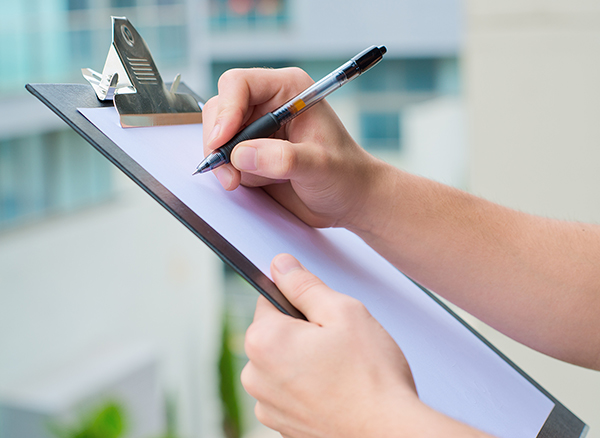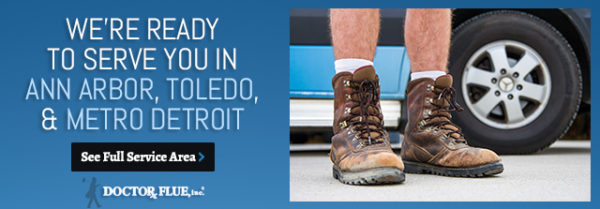
If you plan to use your fireplace this season, you need to make sure it’s safe. The best way to check for safety is to schedule a professional inspection. In the meantime, you can use this checklist to identify if your chimney may have an obvious issue.
Is Your Chimney Odor-Free?
What’s that smell? If that’s the question that runs through your mind when you walk by or open up your fireplace, it’s important to make note of that on your chimney inspection checklist. Certain odors in your chimney can be giveaways to potential issues and a professional inspection can determine the cause.
One of the common causes of chimney odor is creosote. Creosote is a byproduct of smoke and is generated each time you use your fireplace. Creosote smells like tar, even in small quantities. It is typically a fairly pungent smell. There are three stages of creosote build-up. If caught early, creosote is a loose, flaky material that can be easily brushed away. Over time, it turns into a tar-like deposit that often requires special scrapers to remove. Finally, it becomes hardened, making it difficult to remove. Creosote build-up is dangerous and a good indicator that your chimney hasn’t been cleaned recently.
Another culprit that can cause chimney odor is mold. Not only can mold cause your chimney to smell, but musty mold smells can permeate through your whole home if left too long. Mold needs moisture to grow so it stands to reason that chimneys with mold suggest water intrusion or leaks.
Finally, there are things that go bump in the night, or chirp and chatter during the day. Of course, we’re talking about animals. In addition to a variety of sounds, live animals can bring a menagerie of odors. However, so can dead ones. Animal odors in your chimney aren’t just gross, they suggest your chimney cap needs to be repaired or replaced.
Is Your Chimney Protected from Intruders?
Santa Claus may not be considered an intruder, but anything coming into the chimney from the outside indicates a flaw with, or absence of, a chimney cap. (Don’t worry, if Santa is making a stop at your house, he can leave presents even if your chimney cap is in perfect working order!) Looking for signs of foreign objects is something else to add to your chimney inspection checklist.
Examine your fireplace for debris like twigs or leaves that may be coming down your chimney. Trash is another thing that windy days can bring into your chimney. In addition to being disgusting, trash can be a fire hazard or even block the air flow! Then there are animals. Yes this bears repeating, because plenty of animals will find an open chimney to be a great nesting spot. Keep an eye (and an ear) open for signs.
Is Your Chimney Operating Safely?
There are many scenarios which can lead to a chimney being at-risk leaving your home vulnerable and your health in danger. Your chimney inspection checklist should include looking for proper ventilation, airflow, and equipment.
Be sure that your chimney has the proper ventilation. Check to see that your chimney is allowing for good airflow and escape for smoke. When ventilation is compromised, carbon monoxide can build up. Unlike smoke, carbon monoxide is odorless and invisible, so you can’t tell when it is building up in your home. Carbon monoxide poisoning is a serious risk and can result from improper ventilation.
Proper airflow is another thing to look for. While there is the occasional smoke-filled room when someone forgets to open the damper prior to starting a fire, there is another issue related to ventilation that can have its roots in something other than forgetfulness. Puff-backs indicate an issue with airflow in your home and chimney, and they are a potential fire hazard. It may seem like just a nuisance, but smoke puffing back into your home can be caused by many different issues. Each case is unique and if you have verified that your damper is open and in working order and still have puff-backs, schedule a professional inspection to identify the source of your back-puffing issue.
Lastly, be sure your fireplace door is working properly. Operating your fireplace without the proper equipment is dangerous and the door of your fireplace is a key piece of equipment. If you can’t close the door or if it’s damaged, it’s time to replace the door.
Is the Masonry in Good Condition?
Unlike an offhand comment on the internet, bricks and mortar won’t last forever. Over time, there is wear from the effects of the weather like freezing and thawing. The masonry for chimneys will eventually need repairs or replacement.
Cracks or breaks in masonry are a major chimney fire hazard. Checking the masonry is another item to add to your chimney inspection checklist. While it is possible to repair some basic masonry if you’re handy and like taking on DIY projects, most homeowners can’t see every inch of their chimney. Doctor Flue uses specialized camera inspection tools to identify risks in areas most homeowners can’t see on their own.
Was Your Chimney Recently Cleaned?
If you can’t check this item off your chimney inspection checklist, you definitely need to schedule an appointment. Like oil changes for your vehicles, chimney cleanings aren’t a luxury. They are necessary for safe operation of a chimney and should be scheduled regularly.
Creosote build-up eventually reaches a point that’s practically guaranteed to cause a chimney fire or to disrupt airflow and send smoke back into your home. You wouldn’t wait for your engine to seize up to schedule an oil change, so don’t wait for a chimney fire to schedule a chimney inspection and cleaning!
Using Your Chimney Inspection Checklist to Hire the Right Person for the Job
Now that you’ve completed your chimney inspection checklist, you know what’s wrong with your chimney. You can use that information when you schedule an inspection and cleaning to help a professional know what to expect when they arrive.
There are different levels of chimney inspections. You can find out about different types of chimney inspections here. When you are hiring a chimney sweep to inspect, clean or repair your chimney, do your research to make sure they are CSIA certified.
Keep Your Michigan or Ohio Chimney Safe – Call Doctor Flue!
We can inspect and repair your fireplace, stove or chimney to fix any problem! Contact us today to schedule an inspection to help keep your home safe and your fireplace ready for winter.
Call Us: 1-800-438-3583
Email Us: office@drflue.com
Office Hours: Mon-Fri: 8am-4pm
Connect with Doctor Flue on Social Media

